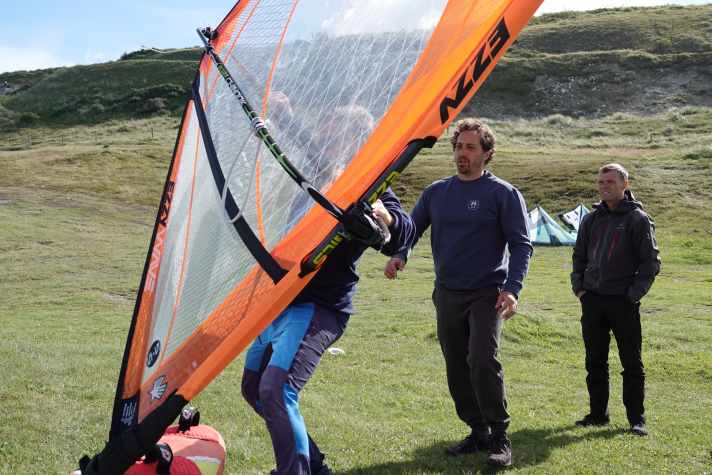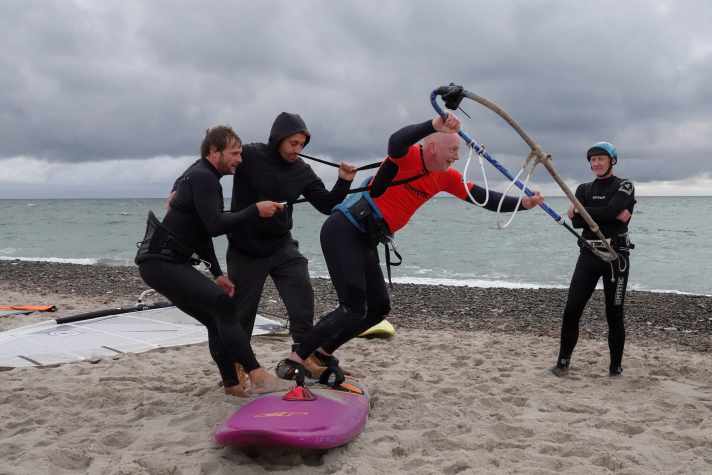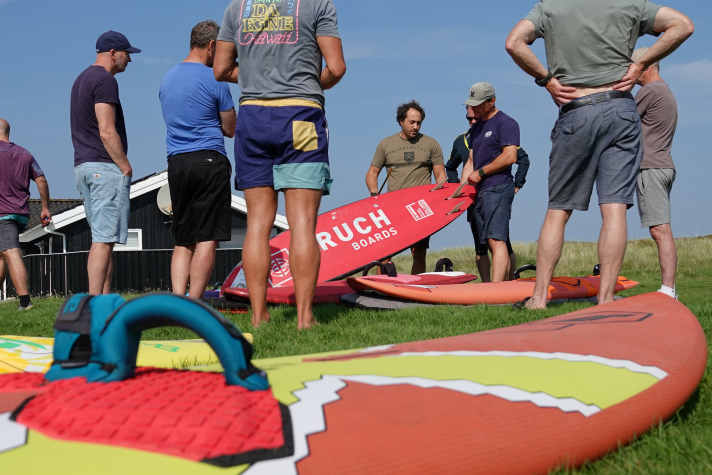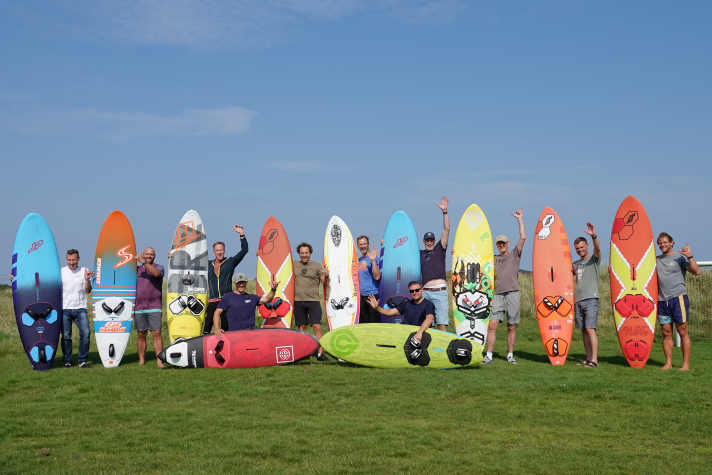Graham Ezzy's Masterclass: "Anyone who sees themselves surfing for the first time is shocked"
Manuel Vogel
· 15.12.2024






Graham, you've been offering online courses and masterclass camps for a few years now. What are they all about and who are they suitable for?
It all started during the coronavirus pandemic. I was on Maui and people around the world were stuck in lockdown. I wanted to bring the windsurfing community together, at least in front of the computer, and started doing livestreams where people could join in and ask questions. The most frequently asked questions were actually about my own riding technique. This led to a number of livestreams on specific coaching topics. Of course, once the pandemic was over, it made sense to meet up not only digitally but also for real coaching sessions. The first masterclass camp then took place in Klitmøller a few years ago and in 2025 there will also be events in Morocco, Gran Canaria and Maui.
Not every good windsurfer is also a good coach. What appeals to you about helping others to improve?
I quickly realised how fulfilling it can be to help others become better - I would never have thought that before. Before that, I always defined myself as a professional through competitions. The stupid thing is that most professionals don't particularly like competitions - unless they win (laughs). Someone is always complaining about the conditions, their own performance, the judging - the vibe is often pretty bad. It's different in coaching, where everyone is happy and has fun together.

What driving level should I have to take part in a masterclass?
As a rule, the group of participants is quite diverse. There are really good wave surfers and people who are just getting into wave riding. To take part, you should feel reasonably comfortable on days with head-high surf, be able to get across the white water safely and be able to hold your height well. In general, it has proven to be an advantage that not everyone is at the same level. The good waver can show off and inspire the others. It also motivates the weaker surfers to try out certain things.
Riding technique is completely irrelevant if you're in the wrong place on the wave
What are the key points of your training concept?
People always think it's all about the technique. They philosophise about backfoot and frontfoot wave riding, about grip and template. Not that any of that is irrelevant, but it's completely useless if you position yourself in the wrong place on the wave when wave riding. You can't just do a bottom turn and then see where you end up, you have to adapt to the wave so that the cutback happens where you get energy from the wave. Only when the timing is right does the rest become relevant.
So timing comes before technology?
I think it makes less sense to think too much about the exact technique, but to think about the function first. For example, you can look at a cutback from a technical perspective: What do the arms do, how do you load the rail, and so on. Or you can approach it from the other side and ask yourself what the function of the cutback is - namely to convert the energy of the wave into a turn. I call it High-five concept. It means that with a good cutback, the breaking lip has to hit the underside of the board. The energy of the wave is then transferred to the board and results in a fast, powerful turn. So as soon as you prioritise the function, you are already unconsciously adapting your technique accordingly.

The energy of a storm becomes wave energy, the energy of the wave becomes board speed - that's what wave riding is all about
Not every waveriding newcomer has the courage and skill to hit a breaking wave lip at the critical point. Instead of a "high five" with the lip of the wave, you might end up with a clip or broken material...
Also, wave newbies should look for breaking wave lips instead of riding bumps on round wave shoulders, otherwise you won't get any energy back and you'll get used to making mistakes. But of course you're right, if the wave height is outside of your comfort zone, it can be respect-inducing. My tip would then be: instead of riding conservative bumps on big but round wave shoulders, go for the smaller breakers or even white water waves and then have 100 per cent confidence to do the high five. I always tell the participants: The bottom turn is your job, the cutback is the wave's job!
With the bottom turn you do the work, with the cutback you do the wave
You also look at the participants' equipment set-up during the events. Are there any typical mistakes that you often notice?
Of course, there are many sources of error here too, but the one I see most often is an incorrect strap setup, as many waveriders have their straps so tight that only their toes are visible. Your feet have to slide in far enough so that you have control of the board when riding downhill. Of course, this is only possible if the straps provide lateral support so that you don't lose control of the board. The straps provide support at the sides, not at the top. The stance is also important, a slightly wider stance gives you the opportunity to get the pressure further onto the tail or forwards.

Let's talk about the second facet of windsurfing in the wave, jumping. If you want to learn a move like the frontloop, you usually have plenty of excuses on the water not to try it. What strategies are useful here?
I know this problem from my own experience when I tried my first double loops. I went out with an impact waistcoat and helmet, full of adrenaline - but then sometimes only made two or three attempts in a two-hour session. Afterwards I was frustrated and hadn't enjoyed the whole time on the water because I had my to-do list in my head the whole time. As a result, I looked at how athletes in other sports learnt new tricks and that time block learning discovered for me.
So practising a new trick in a certain time frame?
Time block learning is the game changer! You define a time window beforehand - this can be anything from ten minutes to 30 minutes - during which you only have one task: Your new move! If your mission is the front loop, you do front loops. You don't just ride back and forth if there is no suitable wave, but actively search for ramps. And if there are no perfect ramps, you do it over less perfect ramps. You don't ride waves, even when the wave of your life rolls in (laughs)! Discipline is absolutely essential, because otherwise you'll quickly get distracted and lose focus. You can get a lot done in 20 minutes and as soon as the time is up, you've done the job, no matter how many attempts you've had and whether they were successful. The topic is out of your head and you can just have fun for the rest of the session and do things that make you feel good without feeling guilty.

You also always have a videographer on the beach who records video footage of the participants, which is then analysed afterwards. What are your experiences with this?
I think it's extremely important to see yourself on video. The first time you see it, you're usually shocked and think: "Is that what it looks like for me? For God's sake!" (laughs). The reason for this is that reality and feeling are often so far apart. But this realisation is salutary, because how can you do something better if you're obviously not doing what you think you're doing? Video footage can help you to adjust your feelings to reality. This allows you to make technical improvements more efficiently. Of course, it would be ideal to see the video footage immediately after the move and make improvements, but even if it happens the next day, the benefits are still great.
How big are the groups at your masterclass events?
I think the perfect group size is somewhere between eight and ten people and I deliberately keep the groups small. It also depends a bit on the spot. The online courses are of course larger, so it also works well with 30 or 40 participants.

How do I register for the courses?
I have a website where all the information can be found. There's also a Facebook group and also at the free live coaching, which takes place every Sunday. on my YouTube channel you can drop by.

